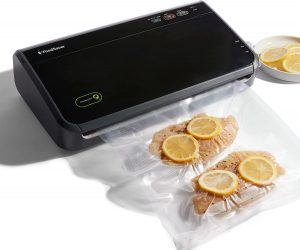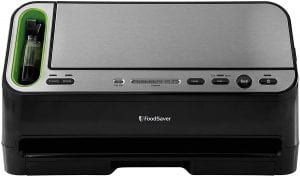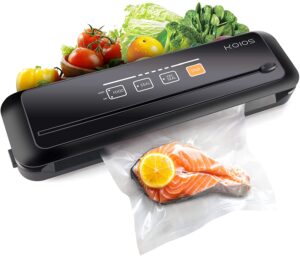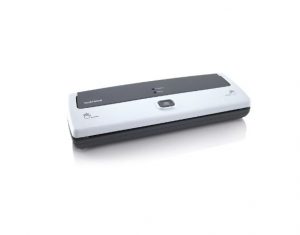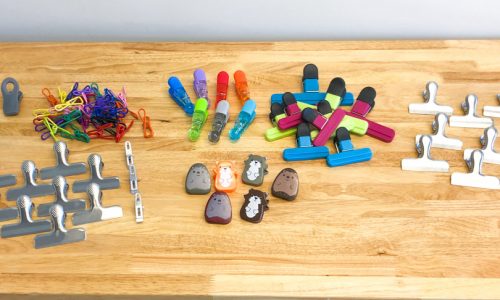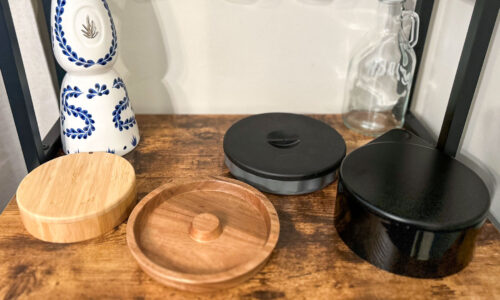The Best Vacuum Sealer

Our Review Process
Don't Waste Your Money is focused on helping you make the best purchasing decision. Our team of experts spends hundreds of hours analyzing, testing, and researching products so you don't have to. Learn more.
Our Picks For The Top Vacuum Sealers
- 1. NutriChef Time Saving Economic Vacuum Sealer
- 2. NESCO Easy-Lock Handle 3-Settings Vacuum Sealer
- 3. Bonsenkitchen Professional LED Vacuum Sealer
- 4. FoodSaver FM2100-000 Food Preserving Built-In Cutter Vacuum Sealer
- 5. FoodSaver Moisture Detecting NRTL Tested Vacuum Sealer
- 6. KOIOS Space-Saving Budget-Friendly Vacuum Sealer
- 7. FoodSaver V2244 Less Waste Customizable Vacuum Sealer
- 8. Weston Pro-2300 Manual Extra Wide Vacuum Sealer
- 9. Seal-A-Meal Taste Preserving Airtight Vacuum Sealer
- 10. FoodSaver GameSaver Anti-Freezer Burn Vacuum Sealer
- 11. NESCO VS-02 One-Touch Convenient Store Vacuum Sealer
- 12. FoodSaver Premium 2-in-1 Vacuum Sealer
- 13. FoodSaver Handheld Dishwasher Safe Tray Vacuum Sealer
- 14. Vremi Electric Fresh Food Vacuum Sealer
- 15. GERYON Multi-Layer Heat Seals Vacuum Sealer
- 16. FoodSaver FM2000 Food Storage Removable Drip Tray Vacuum Sealer
- 17. KOIOS Dry & Moist Mode External Pumping Vacuum Sealer
- 18. Mueller Austria Lab-Tested Digital Vacuum Sealer
- 19. Potane Automatic Electric Vacuum Sealer
- 20. Vsdk One-Touch 7-In-1 Vacuum Sealer
- 21. GERYON Compact Easy Store Vacuum Sealer
Newbies will appreciate the accessible design of this vacuum sealer. The top-panel control center has digital buttons and LED indicator lights for quick sealing. This unit also performed well in laboratory testing.
Easy OperationThis vacuum sealer will become a kitchen staple thanks to its simple controls.
The unique pulse vacuum feature in this appliance makes it perfect for preserving more fragile and food items. This gives the machine a wide range of capabilities. For heavier duty items or liquids, you can even choose to double seal bags. This powerful vacuum sealer takes up a significant amount of counter space, so be sure to make room.
A Powerful PickThis vacuum sealer is perfect for preserving more fragile and food items.
Available in silver, white or black, this vacuum sealer will keep your food fresh longer. It features five operating modes that cover a variety of foods, including meats, nuts and breads. There's even an accessory piece that can be used to remove air from containers and jars.
Economical OptionYou won't have any trouble sticking to your budget, thanks to the affordable price tag on this vacuum sealer.
Cut your food bill and never waste leftovers again with this high-quality vacuum sealer. Once sealed and frozen, your favorite foods can last up to 3 years. The unit features a built-in roll cutter for the perfect size bag every time. It also uses dual heat sealing strips to ensure you get a tight seal.
Multiple Finishes AvailableYou'll find this vacuum sealer comes in a choice of all black, black and silver or white and silver.
Buying Guide
Vacuum sealers are an essential tool for any home cook. Not only will they save you time and money, but using them to preserve food adds unbelievable flavor, making even the simplest dishes stand out.
“The price of a vacuum sealer will quickly be offset by the money you will save, as it can be used to drastically extend the shelf life of pretty much any foodstuff, be it in the pantry, refrigerator or freezer,” says culinary expert Julie Chernoff, food journalist, dining editor for Better magazine and member of Les Dames d’Escoffier.
They do this by packing in juices and preserving the freshness of food, minimizing its contact with air. Airtight environments prevent juices from escaping, keeping food moist. The airtight environment created by a vacuum sealer can also prevent solid foods from hardening since they won’t be absorbing moisture from the surrounding air. This is ideal when you need a long-term storage solution for fruits, vegetables or other perishable food items.
“Air is the enemy of food storage; it causes foods to go stale, get moldy, oxidize, or become rancid,” Chernoff explains. “By removing all of the air from inside a bag, bottle or jar, your food products will be good for much longer. The meat won’t brown in the bag, items stored in the freezer won’t get freezer burn, and dry goods won’t get buggy. You can even put your polished silver in a vacuum-sealed bag to prevent tarnishing from exposure to air! It’s a great tool for people who are into meal prep.”
These handy machines use suction to remove oxygen from plastic vacuum bags, applying heat to firmly seal them closed. Vacuum bags are typically held separate from the oxygen-sucking sealer, but some brands are beginning to combine the two in the same housing. It comes with a possible downside — a bulkier appliance — but you may decide it’s worth it for your needs.
The vacuum sealing method is often confused with shrinkwrapping, but they are distinctly different. Shrinkwrapping isn’t a viable way to preserve food, though it may have similar results within alternative applications, like storing clothes.
Unlike vacuum-sealed items, shrink-wrapped items are enclosed in film, which is effectively shrunk when heat is applied. The film adheres to the item, taking its shape. It removes most of the air but does not truly vacuum seal its contents.
Vacuum sealers work well when preserving meats and seafood, like fish (hint: add a flavor-boosting marinade before sealing to kick things up a notch). Once you’ve sealed it up, pop it in the freezer. Most quality vacuum sealers will create an airtight package that will keep in the freezer for an incredibly long time while preserving taste and minimizing freezer burn. You can say goodbye to throwing away leftovers and hello to buying in bulk without worrying about how to use it before it goes bad.
MORE: Why you should never thaw frozen fish in its vacuum-sealed packaging
You can defrost your vacuum-sealed food while in the vacuum bag, but defrosting must be done in the fridge to allow it to remain at a safe, constant temperature. As such, you’ll need to allow enough time (about 24 hours for every five pounds of meat) for it to comfortably reach the desired temperature before cooking.
If defrosting your sealed food in the fridge is not an option, remove it from its vacuum-sealed bag. The inside of the vacuum bag is not sterile, so leaving perishable items at room temperature should always be avoided as it could result in bacteria growth.
Quality vacuum sealers are essential for adequately preserving products, especially food. That’s why you shouldn’t skimp on quality when choosing your vacuum sealer.
Also, consider what additional features you might want to make vacuum-sealing even easier and more convenient.
“An accessory hose is useful for dry canning and jar sealing,” Chernoff suggests. “Look for a unit with an easily removable/washable drip tray for cleaning up the liquid that sometimes gets sucked into the machine during the sealing process. Bag storage built into the unit is a big plus, as is a built-in cutter. The bigger and better vacuum sealers are likely to have those.”
MORE: The Best Vacuum Sealer Bags
The good news is there are vacuum sealers that will get the job done well at just about every price point, so you have some excellent options!
Our Expert Consultant

Culinary Expert
Julie Chernoff is a long-time member of Les Dames d’Escoffier (past president of the Chicago Chapter, and current co-chair of the LDEI Legacy Awards Committee), the Association of Food Journalists (AFJ) and the International Association of Culinary Professionals.
Chernoff is the dining editor of Better, a lifestyle website and print magazine. Her journalism started in the test kitchens of Weight Watchers Magazine. She holds a BA in English from Yale University and is a graduate of the California Culinary Academy. She has spent the last few decades styling, photographing, teaching, developing recipes, editing, thinking and writing about food.
What to Look For
- Vacuum sealers can come in handy outside the kitchen, too. Next time you’re packing for a long vacation, seal your clothes. They’ll be tightly packed, making room for many more items in your suitcase. Sealing toiletries is also a great way to ensure your bag will be mess-free after a bumpy flight. Additionally, you can use vacuum sealers to protect important papers or photos from dirt and moisture while in storage.
- Price is always a concern when buying a new appliance. The right price point depends on how you intend to use your vacuum sealer. Are you a hunter or fisherman who needs to preserve large quantities of meat? Are you a home cook for a small family? Will you use your vacuum sealer daily? The answers to those questions will help you decide which appliance is best for you. After all, their prices range significantly.
- Marinate meat, seafood or other proteins before storing. This will add an enormous amount of flavor to your dish with minimal effort on your part. Add things like garlic, spices and oil before sealing your vacuum bag. Ensure all the liquid is touching your food item while in the bag to ensure maximum absorption. To allow the marination process to run its course, store your vacuum-sealed food in the fridge for an hour or so. Then, you can store it in the freezer for later use. When you’re ready to cook it, you’ll have a pre-marinated dish full of flavor, saving you tons of valuable time.
- When comparing vacuum sealers, size is important. That’s especially true if you have limited counter and storage space. Not including commercial models, most countertop vacuum sealers range from 15 by 8 inches and 6 pounds to more than twice that size. While larger appliances are less convenient, they typically are more powerful than smaller models.
- Make sure to unplug your appliance before cleaning. Then, use a damp cloth with a mild detergent to wipe down all surfaces. For quick and easy cleaning, look for a machine with a removable and dishwasher-safe drip tray.
- Find a vacuum sealer with a handheld sealer to keep fridge and pantry items, like deli meat and cheese. A handheld sealer will help remove air from containers and zipper bags to keep your everyday food lasting longer and tasting better.
More to Explore
If you have a good vacuum sealer, you’re prepared to try a quirky (but delicious) cooking technique called sous vide. It’s a method of preparing food by partially cooking it, followed by vacuum-sealing and chilling. It can sound odd and unsafe to some, but others swear by it when creating flavorful dishes. Though you don’t always need a vacuum sealer, using one is preferred. Using one is key when cooking delicious veggies — carrots, potatoes, broccoli and onions work best. Just preheat a pot of water, prepare and vacuum seal your vegetables with a splash of oil, and drop them into the hot water until the veggies are crisp, crunchy and tender. Voila!




